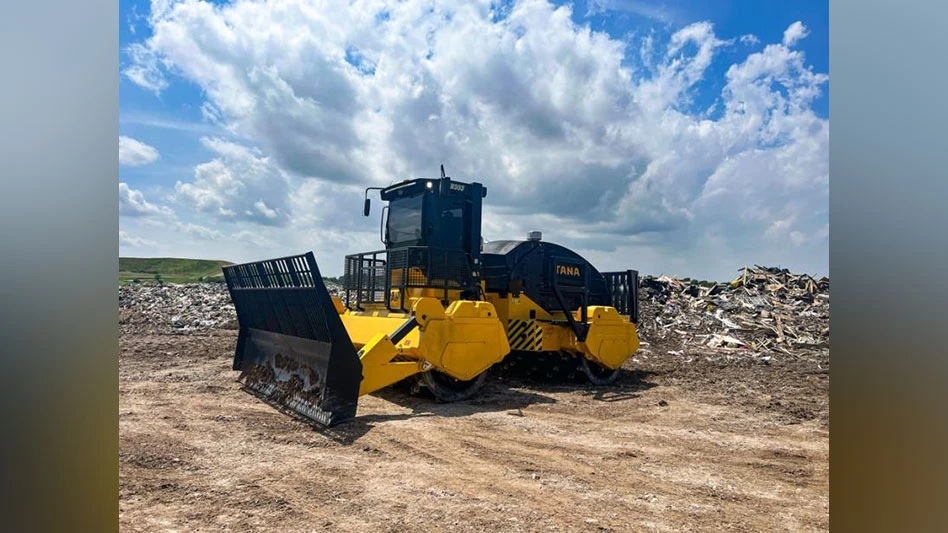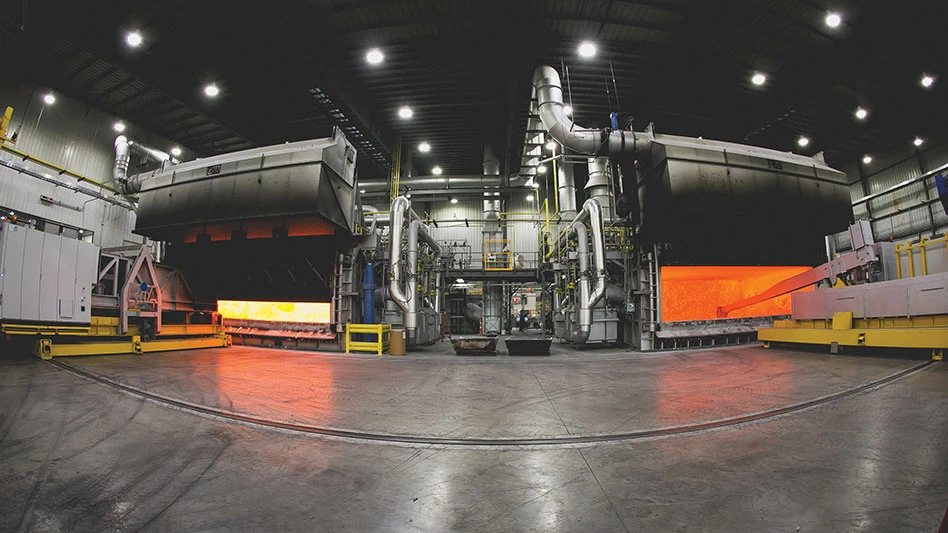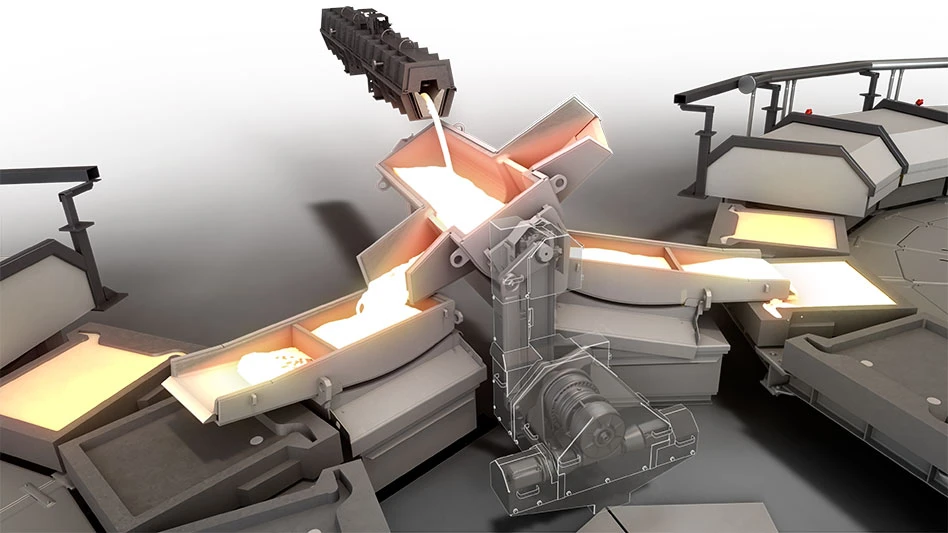The manufacturing industry has provided the scrap recycling industry with a wide range of attachments to meet a variety of handling needs. Grapples come in all shapes and sizes to lift scrap metal and tires; magnets move ferrous scrap; buckets move finer scrap particles; mobile shears cut metal and tire scrap; and crushers pulverize scrap concrete block. And through simple hydraulic controls on the scrap handler, attachments can be opened and closed.
GRAPPLES MOST POPULAR
There are many grapple designs on the market today, including orange-peel, tulip, log, and narrow-tine types. Grapples are not only the most varied of the attachment types, but probably the most popular as well. “Grapples are hot right now,” says one manufacturer. “We are moving a lot of them into the scrap recycling industry.”
Orange-peel grapples have four or more prongs (also called tines or leafs) that are used to pick up scrap.
Tulip grapples are also called full-leaf grapples. In this configuration, the flanges of the tines form a seal when the grapple is closed enabling the attachment to handle small- as well as large-sized scrap.
Both orange-peel and tulip grapples are also referred to as wide-tine grapples.
Narrow-tine grapples have numerous skinny tines that are used to grab softer scrap, such as plastics, cardboard and even tires.
Log grapples were originally designed for the forest industry, but are widely used by scrap recyclers to handle auto hulks and other large pieces of material. These types of grapples normally are configured with two fingers that fold into three fingers. Other types have two large flat fingers, which are more like curved plates that grasp material.
In addition to opening and closing, grapples can also be designed to rotate 360 degrees for better positioning. Grapples also have hardened tips for better wear, and some come with cushioned valving that allows the grapple to open and close more evenly.
Grapples are the workhorses for Jacobson Metal Co., Chesapeake, Va. Jacobson was bought by Recycling Industries Inc., Englewood, Colo. in December of 1997. Jacobson has eight scrap handlers, one outfitted with a mobile shear, one with a magnet and six with grapples. “We like grapples because they can pick up more than magnets,” says George Ginsburg, general manager. “We can load material into a truck about two-times faster with a grapple. And a grapple is the best attachment for handling #1 and #2 ferrous scrap.”
Jacobson, which is in the Tidewater area near Norfolk, exports a lot of scrap, and does on-site processing for the military, which has a major naval presence in that region.
“We currently have a scrap handler on a base under a three-year contract, and that handler has a grapple on it,” he says.
Ginsburg also says that the grapple is ideal for moving auto hulks. “With a grapple you can get two maybe three hulks in the grapple,” he says, “but it is hard to position a magnet for this purpose.”
MAGNETS TO LIFT
However, every ferrous scrap processor needs a magnet, and Ginsburg will also say that is a true statement. “You need the magnet to handle the small stuff,” he says. “Scrap that the grapple can never get. The magnet also is excellent for sweeping an area clean of scrap.” Magnets are especially good at cleaning out the bottom of a truck bed or a railroad gondola car.
Magnets lift ferrous scrap by electromagnet force. This is because the operator has to be able to turn off the magnet field in order to drop the load. Magnets for lifting are round and can be as large as 8 feet in diameter and are able to handle loads up to 10,000 pounds.
Because lifting magnets are charged electrically, they need an onboard magnet controller and a generator to power the electromagnet field.
The controller simply allows the operator to control the electromagnetic field of the magnet. Basically, it turns the field on or off, allowing the magnet to pick up or drop a load. The controller also allows an operator to slowly dissipate the electromagnetic field so scrap can be scattered over a larger area.
The generator supplies the power to the magnet, and power is supplied to the generator by the scrap handler’s onboard hydraulics. Normally a dedicated pump is used for this purpose. On stationary scrap handlers that are electric powered, a rectifier will be needed to convert the incoming AC current to DC current needed by the magnet.
To figure out the proper size of the generator needed to power the magnet, multiply the voltage of the magnet by its cold amps rating. If a magnet is rated at 230 volts and 70 cold amps, then the scrap handler will need a generator rated at a minimum of 16 kilowatts. But it is always a good idea to get a generator that is rated higher to make sure that the magnet will have more than adequate power.
Because of the nature of lifting tough ferrous scrap, magnets have to be encased in a hardened shell. Usually, the bottom of the magnet is extra thick to better protect the coil of the magnet. Manufacturers claim that most of the reason magnets have to be serviced or fail is due to bottom plate trauma, often caused by the magnet diving too fast into a pile or being unnecessarily knocked around.
The top of the magnet has to be a certain thickness, too, because that thickness has to be able to direct the electromagnet field downward.
As for the coils, either aluminum or copper wiring is used. It seems that aluminum is becoming the metal of choice due to its lighter weight, as makers of magnets are trying to keep the weight down as much as possible.
Finally, when shopping for a magnet, be sure to have the dealer explain the rated operating parameters of the attachment. Data such as cold amps, volts, cold kilowatts, coil temperature rise and cold amp turns can be helpful.
MAGNET-GRAPPLE COMBOS
A hybrid attachment that is a relative newcomer to the industry, but has been on the market for several years, is the magnet-grapple. This configuration combines the tines of a standard orange-peel grapple with the capability of a round lifting magnet.
Manufacturers of this type of attachment say it gives scrap handlers the advantages of a magnet with the control of a grapple. “It gives our customers the versatility that they need,” says one manufacturer. The operator can use the magnet to clean up an area, and use the grapple to increase the lifting capacity and hold scrap while de-energizing the magnet, thus saving on magnet wear and tear.
However, one scrap recycler has not warmed up to the magnet-grapple yet. “I like the concept of the magnet-grapple,” says Adam Weitsman, general manager of Weitsman & Son Inc., Owego, N.Y., “but we have yet to find one that has a large enough magnet. When a manufacturer can make one with the size magnet we require, then I will be interested.”
Magnet grapples on the market today have magnets only in the 40- to 50-inch range. Manufacturers and dealers do acknowledge that the challenge has been to design a magnet-grapple with a large magnet because of weight considerations and because of the inherent design. But according to one manufacturer there may be a new development in this area. “We are working on a new magnet-grapple,” says one manufacturer, “however, we are not prepared to make any releases about the nature of our research at this time.”
Reportedly, the new magnet-grapple will have magnetized tines, increasing the capabilities of the attachment.
MOBILE SHEARS TO CUT
Mobile shears have grabbed a solid foothold in the scrap recycling industry. The shear normally works off the scrap handler’s existing hydraulics, so no special equipment is needed. Mobile shears can be as small as an attachment for a skid steer, or they can be heavy-duty models with a cutting force of more than 1,800 tons and with 360-degree rotation for a scrap handler.
Of course, these shears are fitted with replaceable blades, usually four to eight that can be changed out when they become dull. The stationary bottom half of the shear is called the anvil and the moveable top half is called the knife. The blades are placed on both of these sections.
In addition, the knife normally has a small curve at the end or an add-on called a parrot beak. This feature enables the operator to adequately pick up material, such as a pipe, and to secure it in the shear as it is cutting.
Because of the cutting forces required, some mobile shears may require a beefier stick/boom on the handler and a high-pressure hydraulic system, as well. It’s always best to consult with both the attachment and scrap handler manufacturer before the purchasing phase.
The advantages of having a mobile shear are three-fold. First, it relieves the scrap recycler of having to have someone manually cut the scrap with a torch cutter, thus providing for a safer environment. Second, it allows the operator to also sort the scrap after shearing it. And, third, the scrap handler with the shear can more easily maneuver around the yard and scrap heaps, providing for better efficiency.
CRUSHERS TO PULVERIZE
Crushers are jaw-like attachments that have several hardened teeth to break concrete and rock. While a crusher is mainly used for demolition, scrap recyclers can use them to break up reinforced concrete to get at the rebar.
Naturally, attachments get knocked around and banged up diving into piles of scrap, so don’t scrimp when buying one. Look for attachments with oversized pins and bushings. Parts should also be heat treated for maximum wear life, and tines should be heavy-duty. Hydraulic cylinders need to be properly sized to handle the job and adequately protected.
ATTACHMENT ANXIETY
So what’s a scrap recycler to do with so many attachment choices out there – many that have capabilities that overlap? “On the surface, it may seem like there is no method to the madness, as to which scrap handlers get which attachment,” says Weitsman. “But there really are valid reasons. For our feeder yards, we usually have only one scrap handler that has to do a variety of tasks. So, we need attachments that can changeout quickly. Normally, that single handler is shearing first, cutting up scrap, then it has to change to the grapple or magnet.”
For handlers at the main yard, Weitsman says that it is common practice to leave an attachment on the handler all day. “We have 22 scrap handlers, and have just installed a mega shredder, so we need to be operating at peak capacity,” he says. “We can’t be wasting time with attachment changeouts. Therefore, each handler remains dedicated to a specific task as determined by the capability of the attachment.”
Another way to cut down on the inconvenice of attachment changeouts is with a new model of orange peel grapple that has the ability to attach to a lifting magnet.
One vendor of reconditioned scrap handlers says the easy-to-attach grapple is gaining popularity with his customers, most of whom operatre small and medium-sized scrap yards. “You can go back and forth ten or 15 times a day,” he says of the item’s easy attachment abilities. “The tradeoff is that now you’re adding 3,000 pounds of magent plus 2,500 pounds of grapple. The buyer then has to make a choice between downsizing the magnet, increasing the scrap handler size, or lessening its reach,” he also notes.
While converting and selling scrap handlers is this business owner’s focus, he says the attachment considerations are not minor. “This is such an important decision for these guys. They have varying work to do, but not the capital to buy one of each attachment. But they have to have that productivity.”
Sidebar
Attachment Type Lifting Use
Orange Peel Metal/non-metal scrap
Tulip/Full-Leaf Metal/non-metal scrap including small stuff
Narrow Tine Softer scrap, such as cardboard,
plastics, tires
Log Type Large metal scrap, auto hulks
Magnet-Grapple Metal/non-metal scrap
Magnet Ferrous scrap; ideal for sweeping areas
Mobile Shear Safe cutting, moving long metal
scrap pieces
Crusher Pulverize concrete, rock
Maintaining Lifting Magnets
One manufacturer recommends the following preventive maintenance procedures for lifting magnets:
Magnet Case - check for cracks, broken welds, dents, discolored metal and severe wear evidence.
Lifting Lugs (Ears) and Chain - check for cracked welds and approximate percentage of metal remaining.
Terminal Box - check for broken welds, broken lead clamps, compound leakage, wire insulation stress at clamps, dirt accumulation in box and arc tracking (burns) under leads.
Fill Pug - check for stopper damaged/missing and leaking compound or water at threadings.
Magnet Coil - test insulation resistance to ground using an Ohm meter connection between each coil lead and magnet case. Also, check coil resistance by using a volt meter connected across coil leads, and compare with nameplate data.
Bottom Plate - use a straight edge bridged across plate surface to note any concave or convex bending. Also check for scraps, gouges, broken welds, moisture leakage, carbon tracking (electrical arc), hackled or veining patches and metal discolorations.
Pole Shoes - check for broken welds, gouges, wear pattern, broken missing bolts and percentage of shoe metal stock to the bottom plate.
Get curated news on YOUR industry.
Enter your email to receive our newsletters.

Explore the June 1998 Issue
Check out more from this issue and find your next story to read.
Latest from Recycling Today
- Fenix Parts acquires Assured Auto Parts
- PTR appoints new VP of independent hauler sales
- Updated: Grede to close Alabama foundry
- Leadpoint VP of recycling retires
- Study looks at potential impact of chemical recycling on global plastic pollution
- Foreign Pollution Fee Act addresses unfair trade practices of nonmarket economies
- GFL opens new MRF in Edmonton, Alberta
- MTM Critical Metals secures supply agreement with Dynamic Lifecycle Innovations





